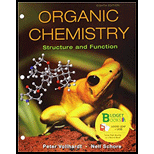
(a)
Interpretation: Out of the nucleophile pairs
Concept introduction: Three principal factors that affect the competition between substitution and elimination: basicity of the nucleophile, steric hindrance in the
Nucleophiles that have large steric bulk such as
(b)
Interpretation: Out of the nucleophile pairs the one that will give a higher elimination: substitution product ratio in reaction with
Concept introduction: Three principal factors that affect the competition between substitution and elimination: basicity of the nucleophile, steric hindrance in the alkyl halide, and steric bulk around the nucleophilic atom.
The bases such as hydroxide ion, alkoxide ion, amide ion, tertiary amines are highly strong bases that favor elimination over substitution. On the other hand bases such as methanol, halides, alkyl phosphines, azides, cyanides, acetates are regarded as weak bases and they form substitution products in greater ratios than elimination products.
(c)
Interpretation: Out of the nucleophile pairs the one that will give a higher elimination: substitution product ratio in reaction with
Concept introduction: Three principal factors that affect the competition between substitution and elimination: basicity of the nucleophile, steric hindrance in the alkyl halide, and steric bulk around the nucleophilic atom.
The bases such as hydroxide ion, alkoxide ion, amide ion, tertiary amines are highly strong bases that favor elimination over substitution. On the other hand bases such as methanol, halides, alkyl phosphines, azides, cyanides, acetates are regarded as weak bases and they form substitution products in greater ratios than elimination products.
(d)
Interpretation: Out of the nucleophile pairs
Concept introduction: Three principal factors that affect the competition between substitution and elimination: basicity of the nucleophile, steric hindrance in the alkyl halide, and steric bulk around the nucleophilic atom. The bases such as hydroxide ion, alkoxide ion, amide ion, tertiary amines are highly strong bases that favor elimination over substitution. On the other hand bases such as methanol, halides, alkyl phosphines, azides, cyanides, acetates are regarded as weak bases and they form substitution products in greater ratios than elimination products.
Nucleophiles that have large steric bulk such as
(e)
Interpretation: Of the nucleophile pairs
Concept introduction: Three principal factors that affect the competition between substitution and elimination: basicity of the nucleophile, steric hindrance in the alkyl halide, and steric bulk around the nucleophilic atom. The bases such as hydroxide ion, alkoxide ion, amide ion, tertiary amines are highly strong bases that favor elimination over substitution. On the other hand bases such as methanol, halides, alkyl phosphines, azides, cyanides, acetates are regarded as weak bases and they form substation products in greater ratios than elimination products.
Nucleophiles that have large steric bulk such as
Want to see the full answer?
Check out a sample textbook solution
Chapter 7 Solutions
ORGANIC CHEMISTRY (LL)-PACKAGE
- When anisole is treated with excess bromine, the reaction gives a product which shows two singlets in 1H NMR. Draw the product.arrow_forward(ii) Draw a reasonable mechanism for the following reaction: CI NaOH heat OH (hint: SNAr Reaction) :arrow_forwardDraw the major product in each of the following reaction:arrow_forward
- Draw the mechanism for the following Friedel-Craft reaction. AlBr3 Brarrow_forward(a) Draw the structures of A and B in the following reaction. (i) NaNH2, NH3(1) A + B (ii) H3O+arrow_forwardFor the reaction 2 N2O5(g) → 4 NO2(g) + O2(g), the following mechanism has been proposed: N2O5 →> NO₂+ NO3_(K1) NO2 + NO3 → N2O5 (k-1) NO2 + NO3 → → NO2 + O2 + NO (K2) NO + N2O5- NO2 + NO2 + NO2 (K3) d[N₂O5] __2k‚k₂[N2O5] Indicate whether the following rate expression is acceptable: dt k₁₁+ k₂arrow_forward
- Consider the following decomposition reaction of N2O5(g): For the reaction 2 N2O5(g) → 4 NO2(g) + O2(g), the following mechanism has been proposed: N2O5 → NO2 + NO3 (K1) NO2 + NO3 → N2O5 (k-1) NO2 + NO3 → NO2 + O2 + NO (K2) NO + N2O5 → NO2 + NO2 + NO2 (K3) Indicate whether the following rate expression is acceptable: d[N2O5] = -k₁[N₂O₂] + K¸₁[NO₂][NO3] - K¸[NO₂]³ dtarrow_forwardIn a reaction of A + B to give C, another compound other than A, B or C may appear in the kinetic equation.arrow_forwardFor the reaction 2 N2O5(g) → 4 NO2(g) + O2(g), the following mechanism has been proposed: N2O5 →> NO₂+ NO3_(K1) NO2 + NO3 → N2O5 (k-1) NO2 + NO3 → → NO2 + O2 + NO (K2) NO + N2O5- NO2 + NO2 + NO2 (K3) d[N₂O5] __2k‚k₂[N2O5] Indicate whether the following rate expression is acceptable: dt k₁₁+ k₂arrow_forward
- Given the reaction R + Q → P, indicate the rate law with respect to R, with respect to P and with respect to P.arrow_forwardSteps and explanations. Also provide, if possible, ways to adress this kind of problems in general.arrow_forwardk₁ Given the reaction A B, indicate k-1 d[A] (A). the rate law with respect to A: (B). the rate law with respect to B: d[B] dt dtarrow_forward
 Organic ChemistryChemistryISBN:9781305580350Author:William H. Brown, Brent L. Iverson, Eric Anslyn, Christopher S. FootePublisher:Cengage Learning
Organic ChemistryChemistryISBN:9781305580350Author:William H. Brown, Brent L. Iverson, Eric Anslyn, Christopher S. FootePublisher:Cengage Learning
